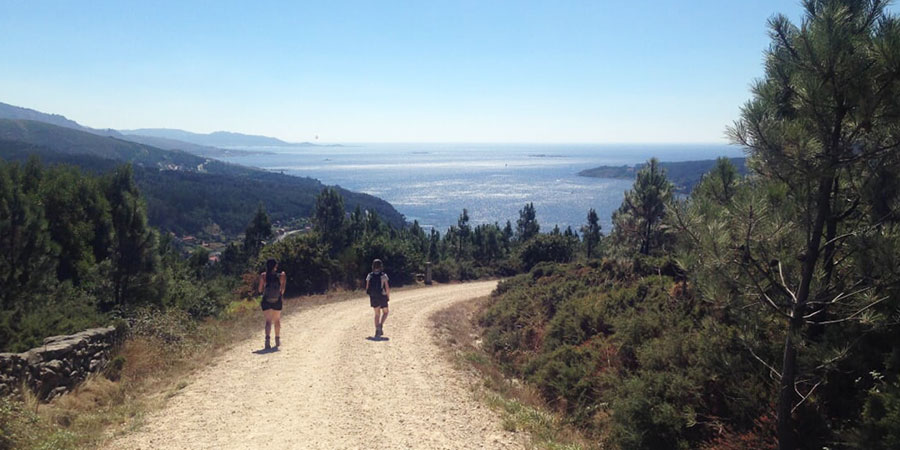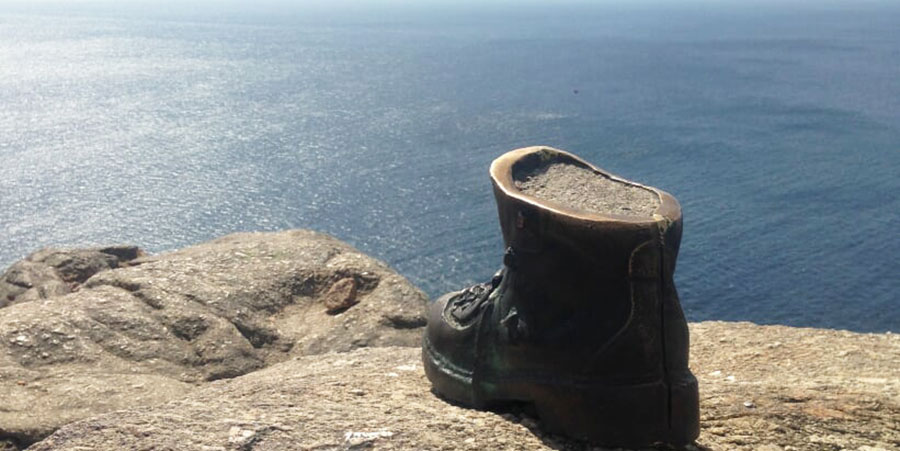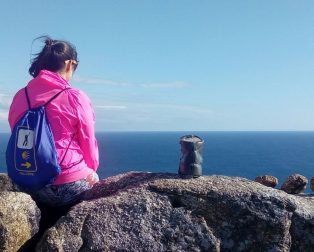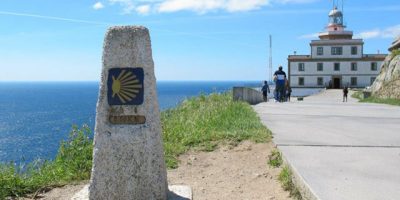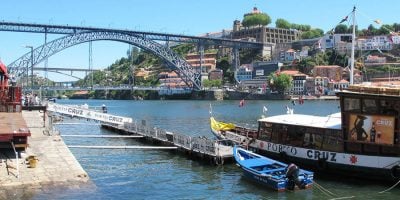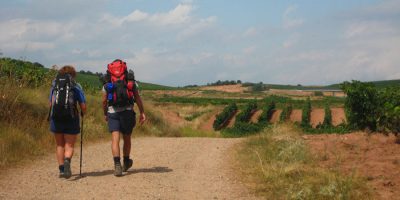Author and freelance journalist Lizzie Enfield shares her experience walking the Camino de Fisterra with her daughter, six years after their first Camino trip together.
Like many travellers on the Camino, I began my journey several years ago, in 2011, cycling a small stretch of the main route with my then 9 year old son. I was seeing what the experience was about, not hiking it in its entirety as I thought ‘proper’ pilgrims did, but doing what many others do, getting a taste for the route, its culture and traditions, the shared experience and the camaraderie. And seeing if you could do it with a small child in tow.
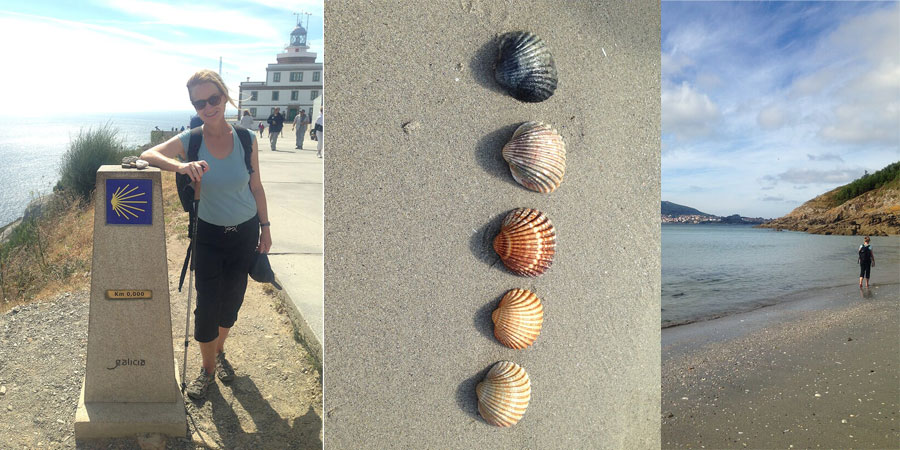
That first trip made me want to go back and I have several times, on each occasion walking a part of a different route.
I took my son again when he was eleven, this time with his thirteen year old sister, Kitty. We walked a stretch of the Portuguese Coastal Camino. Walking up to thirty kilometers a day had a strange effect on the children. They became co-operative, instead of arguing, inquisitive rather than self absorbed and have since referred to it as their “best holiday ever.”
This time I am walking the Camino de Fisterra – a route which predates Christinanity and is the only one to start from Santiago and heads out of the city to the sea.
I am walking it with my now 19 year old daughter, and her friend in the months before they leave to go to university.
We set out from Santiago at 8am and already the square in front of the city’s magnificent Romanesque cathedral is teaming with pilgrims who have spent weeks walking here exhausted and elated by their achievement. It feels odd and slightly wrong to have a spring in our step and no blisters!
The Camino de Fisterra is an ancient 100k way, which passes through quiet villages, oak forests and along mountain paths before reaching the sea cliffs at Fisterra or Finis Terrae (the end of the world) as the Roman’s named the most westerly point of their Empire. Even before then, it was a significant spot for pagans who travelled here to witness the sun ‘die’ after dropping into the sea.
This was where they believed the worlds of the living and the dead began to merge, so it feels fitting to be heading this way as Kitty’s childhood is about to merge with a new adult world. She comments excitedly, as we walk out of the city past many of Santiago’s faculty buildings, before heading into the surrounding hills, through farmland and eucalyptus groves before eventually crossing a medieval bridge just before the town of Negreira, the region’s capital and alluded to by Hemingway in ‘For Whom The Bell Tolls.’
The Fisterra route is much quieter than the ways leading into Santiago. Most pilgrims end their journeys there although some walk the extra four days to Fisterra or Muxia, further north on the Costa da Morte (Coast of Death,) which earned its name because of the number of ships wrecked by the stormy Atlantic waters. We meet a group from Ireland who have already walked 790k from St Jean Pied de Port in France but tell us they reached Santiago and thought, “why not go the extra mile?”
The route with its mix of ancient forests, mountain paths and sea also comes with a distinct sense of its pagan past, the links between the earth and our survival on it.
“Is that a chapel?’ Kitty asks pointing to a minute building on stilts with a cross at either end. It is , in fact, one of the many grain stores, or horreos, which dominate this route where chapels and churches dominate others.
For pilgrims heading towards Santiago a key moment is their first sighting of the cathedral – on this route it’s seeing the sea. We glimpse it on our third day as we head down a mountain path towards the fishing village of Cee, a moment which also allowed us the pleasure of being able to ask “Can you see the sea at Cee?” “Si!”
Shortly before we reach Cee the route splits at the top of a hill where two mileposts, marked with the emblematic scallop shell of St James, send you off in different directions: to Fisterra, where we are heading, or Muxia where legend has it a large rocking stone was the ‘stone boat’ that carried the Virgin Mary to Galicia to visit Saint James.
We take the path to Fisterra heading down along an undulating coastal path before it descends to the vast sandy sweep of Langosteira beach where, since the middle ages, pilgrims stopped to bathe, purifying themselves before the final few kilometers. The water is Atlantic cold but we manage a quick plunge and Kitty searches for “our family” in scallop shells on the beach, laying out a row of five shells of slightly different sizes and ‘hair colours!” – Dad, Mum, older sister, Kitty and her little brother. I take a photograph before a wave comes in and starts to rearrange this shell family that mirrors our own.
We continue to the town of Fisterra, passing through the Praza de Ara-Solis the site (although there are no remains) of the altar to the sun, believed to have been built by the Phoenicians or Celtic tribes
The cape is few km further on and here the end of the world is marked first by a milestone where the mileage is 0 then by a lighthouse, then by a stone cross perched on the rocks beyond and finally just by the rocks beside the sea.
Latter day pilgrims used to burn their clothes and walking boots here but these days it’s seriously frowned upon and enough simply to participate in the other Fisterra tradition – watching the sunset.
We sit and try to imagine what it must have been like for Celts or Phoenicians who believed this was the very end of their world witnessing the sun deity slip into the sea and die, before its rebirth the following day.
Whatever powerful emotions that must have evoked, we have our own.
As we looked across the vast glistening expanse of ocean, with its broad red stroke of sunset slowly spreading, my daughter mused on her forthcoming time at university.
For me, this walk with her to the end of the earth marked the end of a chapter in our lives, for her, looking out towards the horizon it marked the start of new one.
I swallowed hard as the sun disappeared.
Lizzie Enfield is an author and freelance journalist www.elizabethenfield.com
A version of the article first appeared in The Times Newspaper.
For more information about the Camino de Fisterra or to book your trip, contact the CaminoWays.com travel experts

